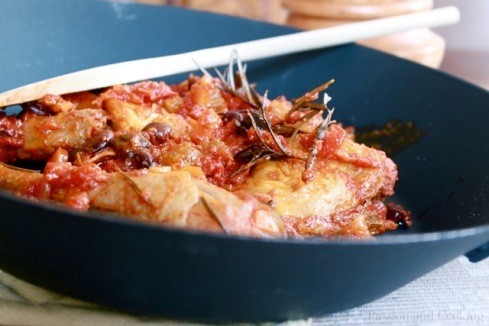In past centuries, peasants used the vegetables cultivated in their fields and the animals raised on their farms to prepare their meals. Pollo alla cacciatora is one of these peasant recipes and seems to have originated in Tuscany. Typically for Sunday dinner, chicken, a readily-available animal, was used to prepare a fine and festive feast. The addition of fresh vegetables such as garlic, carrots, onion, celery, rosemary, tomatoes – as well as a good dose of wine – enhanced the flavor of the meat. The name pollo alla cacciatora makes reference to the ingredients like garlic and rosemary, used by hunters (cacciatori) when cooking. Today we enjoy this delectable dish throughout the peninsula as a second course or else as main course accompanied by mashed potatoes, steamed rise or polenta (for the polenta recipe, see Brasato con polenta). I like this recipe because it is so versatile, and there are many adaptations of the classic recipe (please refer to the notes below for some suggestions). I personally love to add the delicate flavor of Taggiasche olives to my Pollo alla cacciatora; with their fruity-sweet bouquet and delicate mellow taste, they blend very well with the vegetables and the wine. These small dark-green olives are typically from Liguria (Western Riviera) and were originally planted and cultivated by the monks on their land overlooking the sea. Travelling in different countries I have realized that this delicious Italian dish is also well-known and appreciated abroad (no doubt why!!!) and is commonly called Chicken Cacciatore!!!
POLLO ALLA CACCIATORA (HUNTER’S CHICKEN STEW)
Preparation time: 1 ½ hours Servings: 4
INGREDIENTS
1 kg (about 2¼ pounds) chicken, cut into 6-8 pieces or chicken breast cut into cubes
4 tablespoons olive oil (Extra Virgin)
1 sprig fresh rosemary
2 garlic cloves, finely chopped
2 carrots, finely sliced
1 medium onion, finely sliced
2 celery stalks, finely sliced
270 ml (1 cup) dry white wine
450 g (1 pound) canned tomatoes (S. Marzano)
200 g (1 cup) pitted Taggiasche olives in Extra Virgin olive oil
130 ml (½ cup) chicken stock (optional)
Salt and freshly ground black pepper
DIRECTIONS
1. Clean, wash under cold running water and dry the chicken
2. After heating the oil olive in a large nonstick skillet, fry the chicken on medium-high heat for about 10-15 minutes until the chicken pieces are golden brown on both sides
3. Add the rosemary and the vegetables. Season with salt and freshly ground pepper. Cook for 4-5 minutes over medium heat. Add the white wine and cook for additional 5 minutes
4. Add the tomatoes and the olives. Cover and cook for about 20 minutes. Remove the lid and cook for additional 20 minutes until chicken is tender, stirring occasionally. If the liquid evaporates add some chicken stock or water. If you use chicken breast you have to cook only 15-20 minutes, until tender and completely cooked
5. Add a little salt and/or pepper to taste if desired. Remove the rosemary sprig and serve immediately.
Note: Here are some other ingredients you can use when preparing Pollo alla cacciatora:
1. Wine. You can substitute white wine with red wine. Although I prefer to cook chicken in white wine, some people use red wine because it adds a stronger taste to the meat.
2. Olives. You can substitute Taggiasche olives with either the pitted black or green olives that you like the most
3. Peperoncino. Cook the chicken with love, passion and add some fresh or dried peperoncino to spice it up a bit!
4. Mushrooms. You can add 200 g (about ½ pound) champignon mushrooms. Finely slice the mushrooms and add 20 minutes before it is done. You can also use dried mushrooms instead of champignons. Dried porcini mushrooms (about a handful) give a special and woodsy taste to this dish, too. Before using dried mushrooms, soak them in hot – but not boiling – water for about twenty minutes; some (a few tablespoons) of the filtered water can also be used for cooking, to enhance the flavors of your recipe. If you add mushrooms you have to use white wine and avoid olives. -Paola


Paola,
This recipe looks very enticing! Much more complex than my own simple version of Cacciatora. It looks like a “must try!”
Marcia
Thanks Marcia, I am sure it is not too complex for such a good cook as you are! (It is really quite simple, I just use a few more ingredients.) I’ll bet you’ll like it with the olives. Please let me know how it comes out! Paola